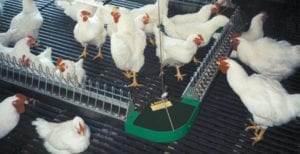Chain Tension and Feed Depth for Broiler Breeder Hens
Chain feeding has been in use for decades. Typically, they require little maintenance, but can be a problem if the tension of the chain in the loop or the feed volume is not right for the birds and equipment.
Chain Tension
 There is a certain tightness needed for belt drive chain systems. For these belt drive systems, I recommend measuring approximately 20 feet from the hopper and pulling the chain straight up with both hands. With a fairly strong pull the chain should be even with the top of the trough. If the chain comes out any further it is too loose and can be cause for pins to shear or the chain to ride up as it comes out of the drive sprocket, or the system may fail to start properly. In the belt drive system, if the chain is too tight, then the corners can wear prematurely. Chain tension on direct drive systems is not nearly as temperamental regarding tightness and is much easier to manage because of this; I prefer the direct drive systems in my recommendations when discussing farm needs and opportunities today.
There is a certain tightness needed for belt drive chain systems. For these belt drive systems, I recommend measuring approximately 20 feet from the hopper and pulling the chain straight up with both hands. With a fairly strong pull the chain should be even with the top of the trough. If the chain comes out any further it is too loose and can be cause for pins to shear or the chain to ride up as it comes out of the drive sprocket, or the system may fail to start properly. In the belt drive system, if the chain is too tight, then the corners can wear prematurely. Chain tension on direct drive systems is not nearly as temperamental regarding tightness and is much easier to manage because of this; I prefer the direct drive systems in my recommendations when discussing farm needs and opportunities today.
Feed Depth
Always properly shut off power to the feed line and perform lock-out tag-out procedures for safety before sticking your fingers inside of the equipment! Measure feed depth at the slide gate. It should be adjusted about ½ to ¾ of an inch above the knuckle of the chain. About a fingertip above the knuckle to the slide gate is my “go to” rule If this slide gate is not adjusted correctly, feed can tend to spill out where it returns into the hopper. Spillage can occur especially if the feed depth is too great.
The feed trough for hens should be raised to about breast height. At this proper height, the bird can easily reach the feed.
An additional adjustment that should be observed – the slide plate over the return packer wheel. This plate should only be about 1/8 of an inch off the return wheel to prevent feed from spilling back onto the chain as it enters the hopper. Feed spillage can lead to poor feed conversion and of equal importance, it can be an invitation to rodents.
Subscribe to our blog!
